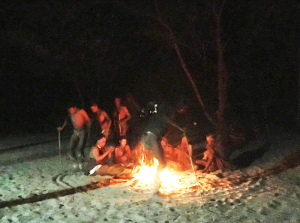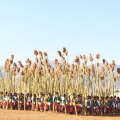
Kyoto University
Specially Appointed Associate Professor, Center for African Area Studies
Junko Maruyama
07/10/2016-10/01/2016
– Centre for African Language Diversity, University of Cape Town
-Mbabane and its surrounding area, Swaziland
-Ghanzi District, Botswana
-Tsumkwe District, Namibia
1.
This research project aims to elucidate contemporary dynamics and reshaping process of “traditional culture” and “ethnicity” of several groups in Southern Africa. Taking a case-sensitive approach to San communities in Botswana and South Africa, and the Swazi communities in Swaziland, the following three aspects are focused; 1. Land rights movement, 2. Traditional authority and leadership, 3. Traditional cultural tourism. The local strategies, interaction among the neighboring ethnic groups, and the relations with national and global communities in the three occasion are investigated. The research highlights the shared experiences among the different target communities reflecting macro level southern African political economical situation and history, as well as the distinctiveness of each communities in in different national and historical contexts.
2.
South Africa: Along with the fruitful discussion with several colleagues at the University of Cape Town, I could learn from Prof. Brenzinger, Director of Centre for African Language Diversity about his rich experiences of developing user-friendly San language materials based on the linguistic documentation. Furthermore, I had a chance to attend some social events organized by the Khoi-San peoples living in and around Cape Town and listen many stories of their history and ethnicity/identity. To interview and exchange ideas, I visited some organizations working on the San’s tourism, indigenous networking and land issues.
Swaziland: A preliminary research on the cultural tourism and traditional authorities was conducted. I visited several community-based tourism sites and explored how they are using their traditional culture as tourism resources. In addition, I was invited a community to learn famous cultural event of the Swazi, called Umtlanga ceremony or reed dance. Academic networking with researchers of the University of Swaziland and consultants were established as well.
Botswana: I visited several NGOs and private companies working on the San’s language project, indigenous issues and cultural tourism. To understand the impact of the tourism on San’s livelihood activities, interviews and participant observations were conducted in the community that I have researched for long time.
Namibia, I went to several different types of tourism site of the San to get a whole picture of so-called “Bushman/San tourism” in Southern Africa.
3.
The highlight of this filed work was visiting to Swaziland. Swaziland is an absolute monarchy ruled by the King of the Swazi, and has unique history of its nation building. Reflecting the history, it was found out that traditional ceremonies and their related cultural activities play key role for both their daily life and tourism scenes of the Swazi. Local peoples as well as academics in Swaziland were kind and showed a cooperative attitude to my research plan.
It was also very interesting for me to know that the community-based “Bushman tourism” had become very active in many places in South Africa, Botswana and Namibia.
4.
In Swaziland, some possible research fields were identified and good relations with peoples were established. I had sense of the possibilities of the development of this research project in my next visit to Swaziland. In addition, during this field work I collected enough data for writing a paper on the cultural tourism of the San peoples in southern Africa. Most part of the research conducted as planned, while the research in South Africa was not as progressive as I wanted to make, because of my injuries.
5.
Writing up the paper on cultural tourism will be one of the important mission during my next trip to McGill University in Canada. Furthermore, I would like to learn from on-going anthropological research on current indigenous affairs in Canada, to understand the linkage between African indigenous rights movement and those of their senior counterpart in North America, as well as to consider the particularity of the African movement.












